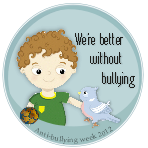
http://www.kn.att.com/wired/fil/pages/webbullyingje.html

created by jennkatie
DSU
Introduction |
The Task |
The Process |
Conclusion |
When we study complex topics, there is usually a lot more to a topic than we learn after a quick exploration. In the following WebQuest, you will use the power of teamwork to learn all about Bullying. Each person on your team will become an expert on some aspect of Bullying and then you will come together at the end to share and get a better understanding of the topic as a whole.
Each person on your team has been assigned a specific role. You will use the links provided to become experts on your roles. You will use your roles to help answer how bullying can be prevented and why bullying is bad.
After completing this WebQuests you should be able to answer the question:
How can Bullying be prevented and why is it bad?
You will be working together as a group exploring web sites that your teacher has selected. You should start with the pages that are labeled 'Background Information' before dividing into groups. Each group has their own Task to complete and a separate set of web sites to use. Carefully consider the roles you are given, and be sure to answer the webquest from that perspective. When you reform as a group to share what you learn and reach consensus, represent your role in the process.
Phase 1 - Background Information
These sites are important because they will provide basic information about the topic as a whole.
Phase 2 - Roles
These roles were chosen because they each define the most important elements of Bullying. Each of you has been assigned a particular role with links and instructions below. Here are the general instructions for all of you. Please see your specific instructions and questions below.
INSTRUCTIONS:
1. One member from each WebQuest team will explore one of the roles below.
2. Read through the files designated for your group.
3. Remember to include the URL of the page you take information from so you can return to it and use it as a citation.Guidance Counselor:
The answers for these questions can be found within all of these websites and your own conclusions.
1. What are good techniques that might work to prevent bullying?
2. What would you do as a counselor to set up a bully prevention plan at your school?
3. What is the first step you would take if a student who was being bullied came to you?
4. List one website not listed on this page, and explain why it is helpful for guidance counselors in understanding bullying.Parent:
- Kalamazoo's College Website for Parents
- Bullying and your Child
- 10 things parents can do to prevent bullying
The answers for these questions can be found within all of these websites and your own conclusions.
1. What would you tell your child if they were being bullied?
2. What are some signs to look for as a parent?
3. What would be the first thing you would do as a parent?
4. List one website not listed on this page, and explain why it is helpful for parents in understanding bullying.
Bullied Student:
The answers for these questions can be found within all of these websites and your own conclusions.
1. What are ways to avoid being bullied?
2. What would/could you do in your school to stop bullying?
3. What steps would you take if you are being bullied?
4. List one website not listed on this page, and explain why it is helpful student victims in understanding bullying.Bully:
- Are You Bullying Someone?
- Bullies: Are you a Bully?
- Are you a Bully? -- Quiz (Relational Aggression)
The answers for these questions can be found within all of these websites and your own conclusions.
1. Are you a bully? Why or Why not?
2. How could a bully accomplish something without being mean?
3. Where could a bully go to find help?
4. List one website not listed on this page, and explain why it is helpful for bullies in understanding bullying.
Phase 3 - Reaching Consensus
You have all learned about different roles of Bullying.
Now the groups come back together after learning about their role in bullying.
As a group you should now come up with an answer to the main question: How can Bullying be prevented and why is it bad? Some of you might not agree but try to come to a consensus.
Use the information found on the websites to convince your group members that your viewpoint is important and should be part of your groups response.
If you only know part of the picture, then you can't understand the whole topic. Hopefully this helped you to learn more about the broad topic of bullying.
How can you use what you've learned to see beyond the black and white of a topic and into the grayer areas?
What other parts of Bullying could still be explored?
Remember, learning never stops.
Post BOTH individual role responses (as an individual) and group responses to the bullying discussion forum.
 |
Content by jennkatie, http://www.kn.att.com/wired/fil/pages/webbullyingje.html |